Open Innovation and Drug Discovery: Eli Lilly's OIDD Platform Essay
VerifiedAdded on 2022/08/18
|13
|3804
|15
Essay
AI Summary
This essay examines Eli Lilly's Open Innovation Drug Discovery (OIDD) platform, exploring its structure, features, and evolution within the pharmaceutical industry. It delves into the concept of open innovation, outlining its benefits and challenges, and provides a concise summary of the theory. The essay details the OIDD platform, its structure, and how it facilitates collaboration between Eli Lilly researchers and external scientists. It analyzes the success factors of the OIDD platform, highlighting the challenges faced by Eli Lilly in adopting the open innovation model, including strategic, operational, legal, and cultural hurdles. The essay proposes solutions to overcome these challenges, such as integrating internal and external resources, establishing a clear vision, and managing coordination costs. The analysis underscores the importance of open innovation in the modern pharmaceutical landscape, emphasizing its potential to accelerate drug discovery and enhance competitive advantage. The essay also mentions the structure of the OIDD program includes a web-based interface that acts as the central point for connecting external scientists with the scientists who work for the organization with the help of the secure portal, all the participants can upload as well as submit structures of the compound that needs to be evacuated for novelty and possess reasonable drug like characteristics.

Running head: MEDICAL
MEDICAL
Name of the Student
Name of the University
Author Note
MEDICAL
Name of the Student
Name of the University
Author Note
Paraphrase This Document
Need a fresh take? Get an instant paraphrase of this document with our AI Paraphraser
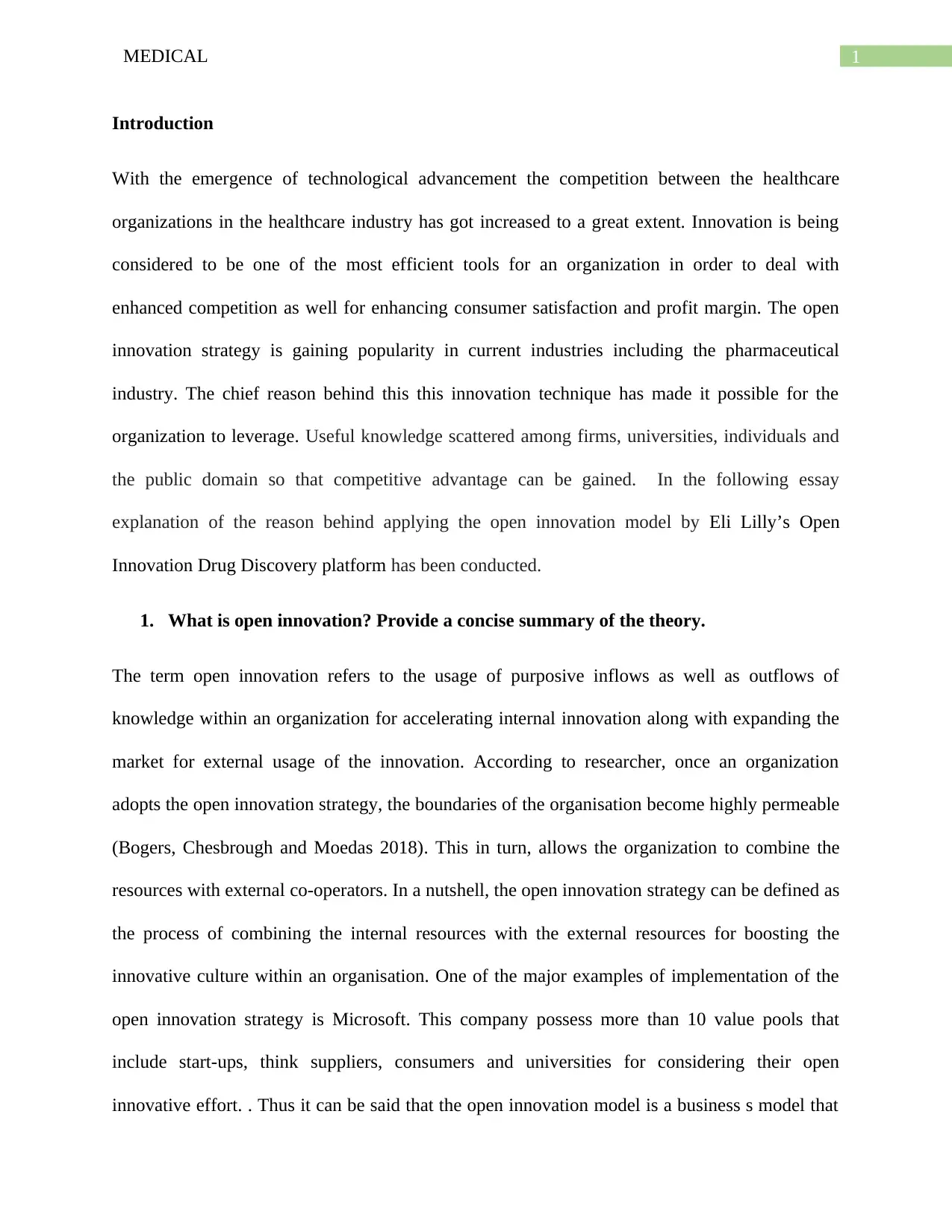
1MEDICAL
Introduction
With the emergence of technological advancement the competition between the healthcare
organizations in the healthcare industry has got increased to a great extent. Innovation is being
considered to be one of the most efficient tools for an organization in order to deal with
enhanced competition as well for enhancing consumer satisfaction and profit margin. The open
innovation strategy is gaining popularity in current industries including the pharmaceutical
industry. The chief reason behind this this innovation technique has made it possible for the
organization to leverage. Useful knowledge scattered among firms, universities, individuals and
the public domain so that competitive advantage can be gained. In the following essay
explanation of the reason behind applying the open innovation model by Eli Lilly’s Open
Innovation Drug Discovery platform has been conducted.
1. What is open innovation? Provide a concise summary of the theory.
The term open innovation refers to the usage of purposive inflows as well as outflows of
knowledge within an organization for accelerating internal innovation along with expanding the
market for external usage of the innovation. According to researcher, once an organization
adopts the open innovation strategy, the boundaries of the organisation become highly permeable
(Bogers, Chesbrough and Moedas 2018). This in turn, allows the organization to combine the
resources with external co-operators. In a nutshell, the open innovation strategy can be defined as
the process of combining the internal resources with the external resources for boosting the
innovative culture within an organisation. One of the major examples of implementation of the
open innovation strategy is Microsoft. This company possess more than 10 value pools that
include start-ups, think suppliers, consumers and universities for considering their open
innovative effort. . Thus it can be said that the open innovation model is a business s model that
Introduction
With the emergence of technological advancement the competition between the healthcare
organizations in the healthcare industry has got increased to a great extent. Innovation is being
considered to be one of the most efficient tools for an organization in order to deal with
enhanced competition as well for enhancing consumer satisfaction and profit margin. The open
innovation strategy is gaining popularity in current industries including the pharmaceutical
industry. The chief reason behind this this innovation technique has made it possible for the
organization to leverage. Useful knowledge scattered among firms, universities, individuals and
the public domain so that competitive advantage can be gained. In the following essay
explanation of the reason behind applying the open innovation model by Eli Lilly’s Open
Innovation Drug Discovery platform has been conducted.
1. What is open innovation? Provide a concise summary of the theory.
The term open innovation refers to the usage of purposive inflows as well as outflows of
knowledge within an organization for accelerating internal innovation along with expanding the
market for external usage of the innovation. According to researcher, once an organization
adopts the open innovation strategy, the boundaries of the organisation become highly permeable
(Bogers, Chesbrough and Moedas 2018). This in turn, allows the organization to combine the
resources with external co-operators. In a nutshell, the open innovation strategy can be defined as
the process of combining the internal resources with the external resources for boosting the
innovative culture within an organisation. One of the major examples of implementation of the
open innovation strategy is Microsoft. This company possess more than 10 value pools that
include start-ups, think suppliers, consumers and universities for considering their open
innovative effort. . Thus it can be said that the open innovation model is a business s model that
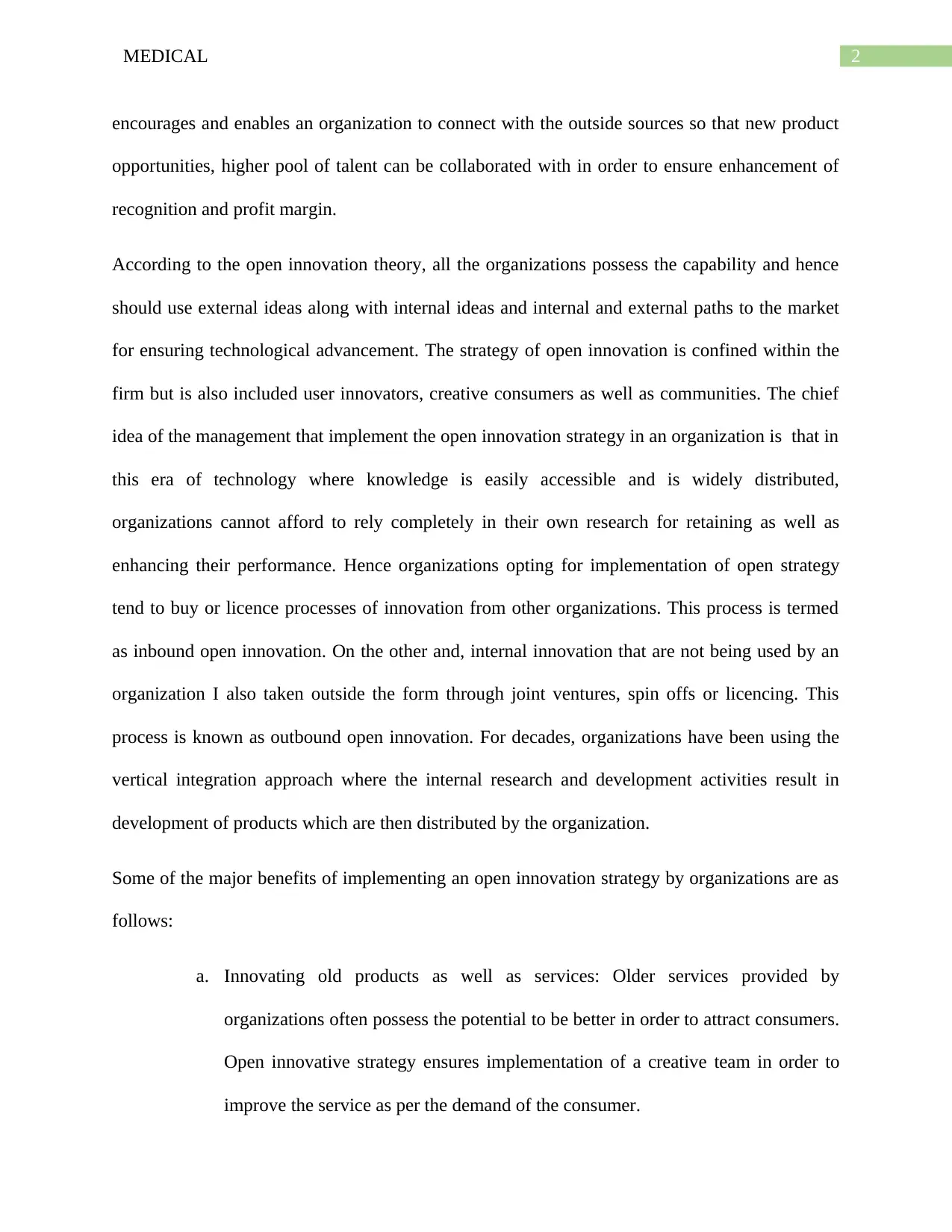
2MEDICAL
encourages and enables an organization to connect with the outside sources so that new product
opportunities, higher pool of talent can be collaborated with in order to ensure enhancement of
recognition and profit margin.
According to the open innovation theory, all the organizations possess the capability and hence
should use external ideas along with internal ideas and internal and external paths to the market
for ensuring technological advancement. The strategy of open innovation is confined within the
firm but is also included user innovators, creative consumers as well as communities. The chief
idea of the management that implement the open innovation strategy in an organization is that in
this era of technology where knowledge is easily accessible and is widely distributed,
organizations cannot afford to rely completely in their own research for retaining as well as
enhancing their performance. Hence organizations opting for implementation of open strategy
tend to buy or licence processes of innovation from other organizations. This process is termed
as inbound open innovation. On the other and, internal innovation that are not being used by an
organization I also taken outside the form through joint ventures, spin offs or licencing. This
process is known as outbound open innovation. For decades, organizations have been using the
vertical integration approach where the internal research and development activities result in
development of products which are then distributed by the organization.
Some of the major benefits of implementing an open innovation strategy by organizations are as
follows:
a. Innovating old products as well as services: Older services provided by
organizations often possess the potential to be better in order to attract consumers.
Open innovative strategy ensures implementation of a creative team in order to
improve the service as per the demand of the consumer.
encourages and enables an organization to connect with the outside sources so that new product
opportunities, higher pool of talent can be collaborated with in order to ensure enhancement of
recognition and profit margin.
According to the open innovation theory, all the organizations possess the capability and hence
should use external ideas along with internal ideas and internal and external paths to the market
for ensuring technological advancement. The strategy of open innovation is confined within the
firm but is also included user innovators, creative consumers as well as communities. The chief
idea of the management that implement the open innovation strategy in an organization is that in
this era of technology where knowledge is easily accessible and is widely distributed,
organizations cannot afford to rely completely in their own research for retaining as well as
enhancing their performance. Hence organizations opting for implementation of open strategy
tend to buy or licence processes of innovation from other organizations. This process is termed
as inbound open innovation. On the other and, internal innovation that are not being used by an
organization I also taken outside the form through joint ventures, spin offs or licencing. This
process is known as outbound open innovation. For decades, organizations have been using the
vertical integration approach where the internal research and development activities result in
development of products which are then distributed by the organization.
Some of the major benefits of implementing an open innovation strategy by organizations are as
follows:
a. Innovating old products as well as services: Older services provided by
organizations often possess the potential to be better in order to attract consumers.
Open innovative strategy ensures implementation of a creative team in order to
improve the service as per the demand of the consumer.
⊘ This is a preview!⊘
Do you want full access?
Subscribe today to unlock all pages.

Trusted by 1+ million students worldwide
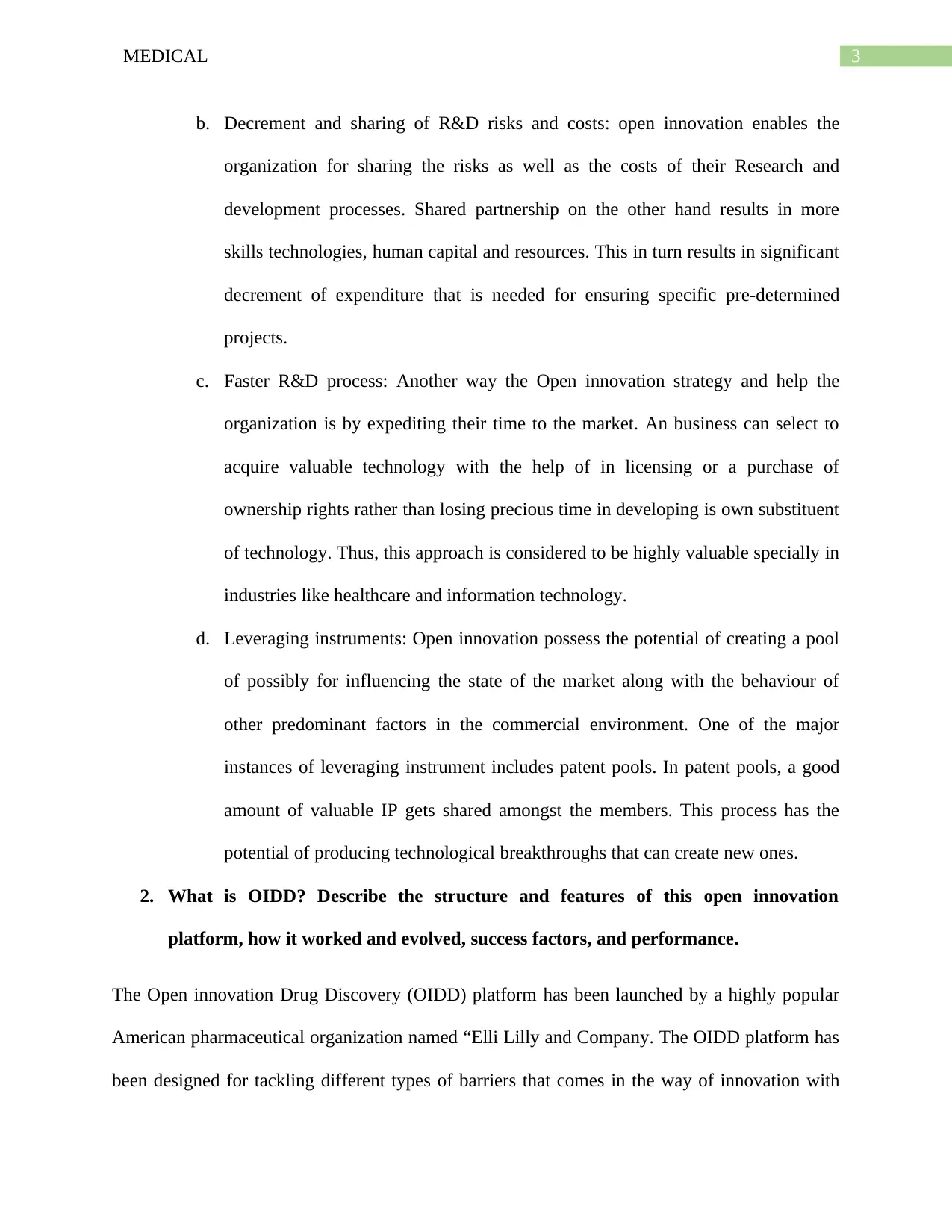
3MEDICAL
b. Decrement and sharing of R&D risks and costs: open innovation enables the
organization for sharing the risks as well as the costs of their Research and
development processes. Shared partnership on the other hand results in more
skills technologies, human capital and resources. This in turn results in significant
decrement of expenditure that is needed for ensuring specific pre-determined
projects.
c. Faster R&D process: Another way the Open innovation strategy and help the
organization is by expediting their time to the market. An business can select to
acquire valuable technology with the help of in licensing or a purchase of
ownership rights rather than losing precious time in developing is own substituent
of technology. Thus, this approach is considered to be highly valuable specially in
industries like healthcare and information technology.
d. Leveraging instruments: Open innovation possess the potential of creating a pool
of possibly for influencing the state of the market along with the behaviour of
other predominant factors in the commercial environment. One of the major
instances of leveraging instrument includes patent pools. In patent pools, a good
amount of valuable IP gets shared amongst the members. This process has the
potential of producing technological breakthroughs that can create new ones.
2. What is OIDD? Describe the structure and features of this open innovation
platform, how it worked and evolved, success factors, and performance.
The Open innovation Drug Discovery (OIDD) platform has been launched by a highly popular
American pharmaceutical organization named “Elli Lilly and Company. The OIDD platform has
been designed for tackling different types of barriers that comes in the way of innovation with
b. Decrement and sharing of R&D risks and costs: open innovation enables the
organization for sharing the risks as well as the costs of their Research and
development processes. Shared partnership on the other hand results in more
skills technologies, human capital and resources. This in turn results in significant
decrement of expenditure that is needed for ensuring specific pre-determined
projects.
c. Faster R&D process: Another way the Open innovation strategy and help the
organization is by expediting their time to the market. An business can select to
acquire valuable technology with the help of in licensing or a purchase of
ownership rights rather than losing precious time in developing is own substituent
of technology. Thus, this approach is considered to be highly valuable specially in
industries like healthcare and information technology.
d. Leveraging instruments: Open innovation possess the potential of creating a pool
of possibly for influencing the state of the market along with the behaviour of
other predominant factors in the commercial environment. One of the major
instances of leveraging instrument includes patent pools. In patent pools, a good
amount of valuable IP gets shared amongst the members. This process has the
potential of producing technological breakthroughs that can create new ones.
2. What is OIDD? Describe the structure and features of this open innovation
platform, how it worked and evolved, success factors, and performance.
The Open innovation Drug Discovery (OIDD) platform has been launched by a highly popular
American pharmaceutical organization named “Elli Lilly and Company. The OIDD platform has
been designed for tackling different types of barriers that comes in the way of innovation with
Paraphrase This Document
Need a fresh take? Get an instant paraphrase of this document with our AI Paraphraser
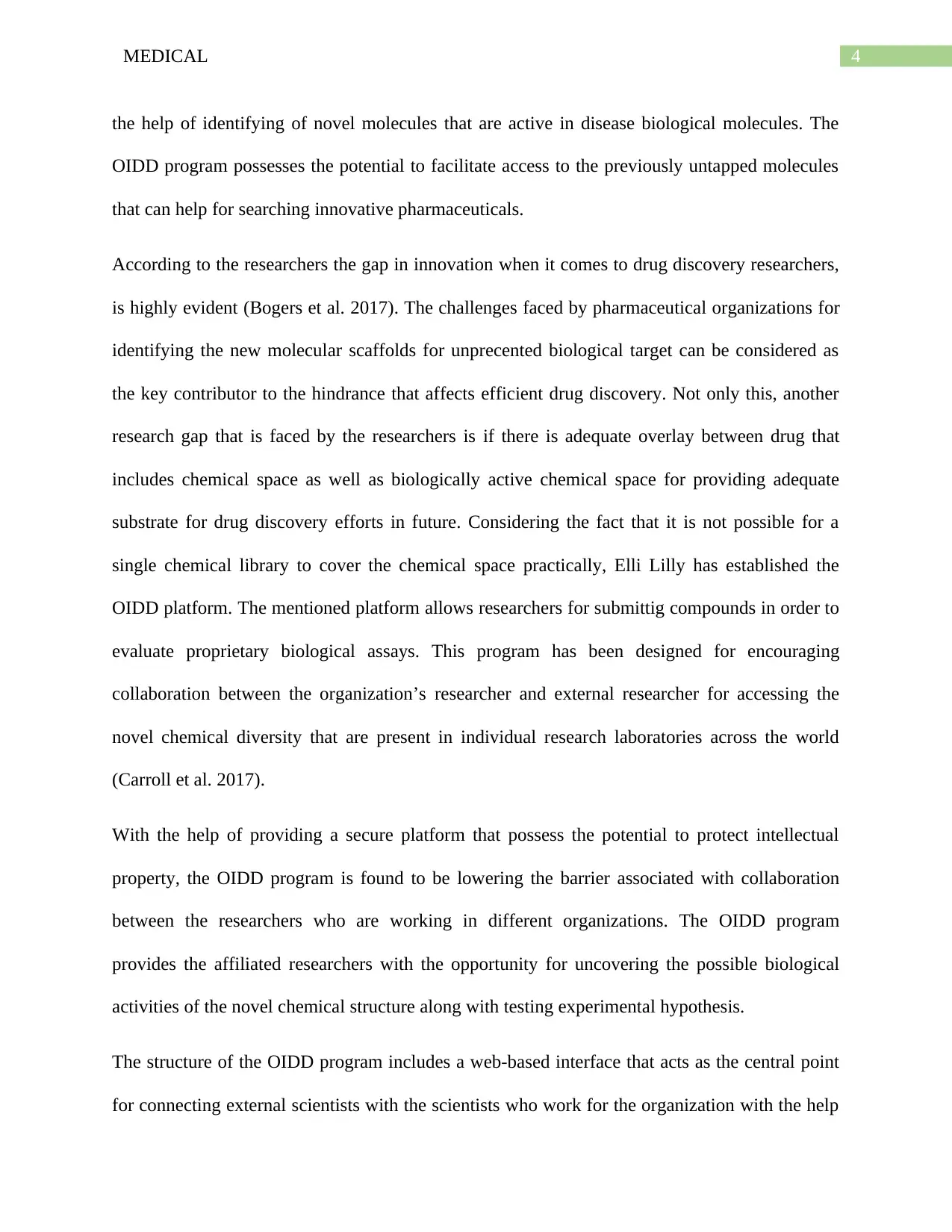
4MEDICAL
the help of identifying of novel molecules that are active in disease biological molecules. The
OIDD program possesses the potential to facilitate access to the previously untapped molecules
that can help for searching innovative pharmaceuticals.
According to the researchers the gap in innovation when it comes to drug discovery researchers,
is highly evident (Bogers et al. 2017). The challenges faced by pharmaceutical organizations for
identifying the new molecular scaffolds for unprecented biological target can be considered as
the key contributor to the hindrance that affects efficient drug discovery. Not only this, another
research gap that is faced by the researchers is if there is adequate overlay between drug that
includes chemical space as well as biologically active chemical space for providing adequate
substrate for drug discovery efforts in future. Considering the fact that it is not possible for a
single chemical library to cover the chemical space practically, Elli Lilly has established the
OIDD platform. The mentioned platform allows researchers for submittig compounds in order to
evaluate proprietary biological assays. This program has been designed for encouraging
collaboration between the organization’s researcher and external researcher for accessing the
novel chemical diversity that are present in individual research laboratories across the world
(Carroll et al. 2017).
With the help of providing a secure platform that possess the potential to protect intellectual
property, the OIDD program is found to be lowering the barrier associated with collaboration
between the researchers who are working in different organizations. The OIDD program
provides the affiliated researchers with the opportunity for uncovering the possible biological
activities of the novel chemical structure along with testing experimental hypothesis.
The structure of the OIDD program includes a web-based interface that acts as the central point
for connecting external scientists with the scientists who work for the organization with the help
the help of identifying of novel molecules that are active in disease biological molecules. The
OIDD program possesses the potential to facilitate access to the previously untapped molecules
that can help for searching innovative pharmaceuticals.
According to the researchers the gap in innovation when it comes to drug discovery researchers,
is highly evident (Bogers et al. 2017). The challenges faced by pharmaceutical organizations for
identifying the new molecular scaffolds for unprecented biological target can be considered as
the key contributor to the hindrance that affects efficient drug discovery. Not only this, another
research gap that is faced by the researchers is if there is adequate overlay between drug that
includes chemical space as well as biologically active chemical space for providing adequate
substrate for drug discovery efforts in future. Considering the fact that it is not possible for a
single chemical library to cover the chemical space practically, Elli Lilly has established the
OIDD platform. The mentioned platform allows researchers for submittig compounds in order to
evaluate proprietary biological assays. This program has been designed for encouraging
collaboration between the organization’s researcher and external researcher for accessing the
novel chemical diversity that are present in individual research laboratories across the world
(Carroll et al. 2017).
With the help of providing a secure platform that possess the potential to protect intellectual
property, the OIDD program is found to be lowering the barrier associated with collaboration
between the researchers who are working in different organizations. The OIDD program
provides the affiliated researchers with the opportunity for uncovering the possible biological
activities of the novel chemical structure along with testing experimental hypothesis.
The structure of the OIDD program includes a web-based interface that acts as the central point
for connecting external scientists with the scientists who work for the organization with the help
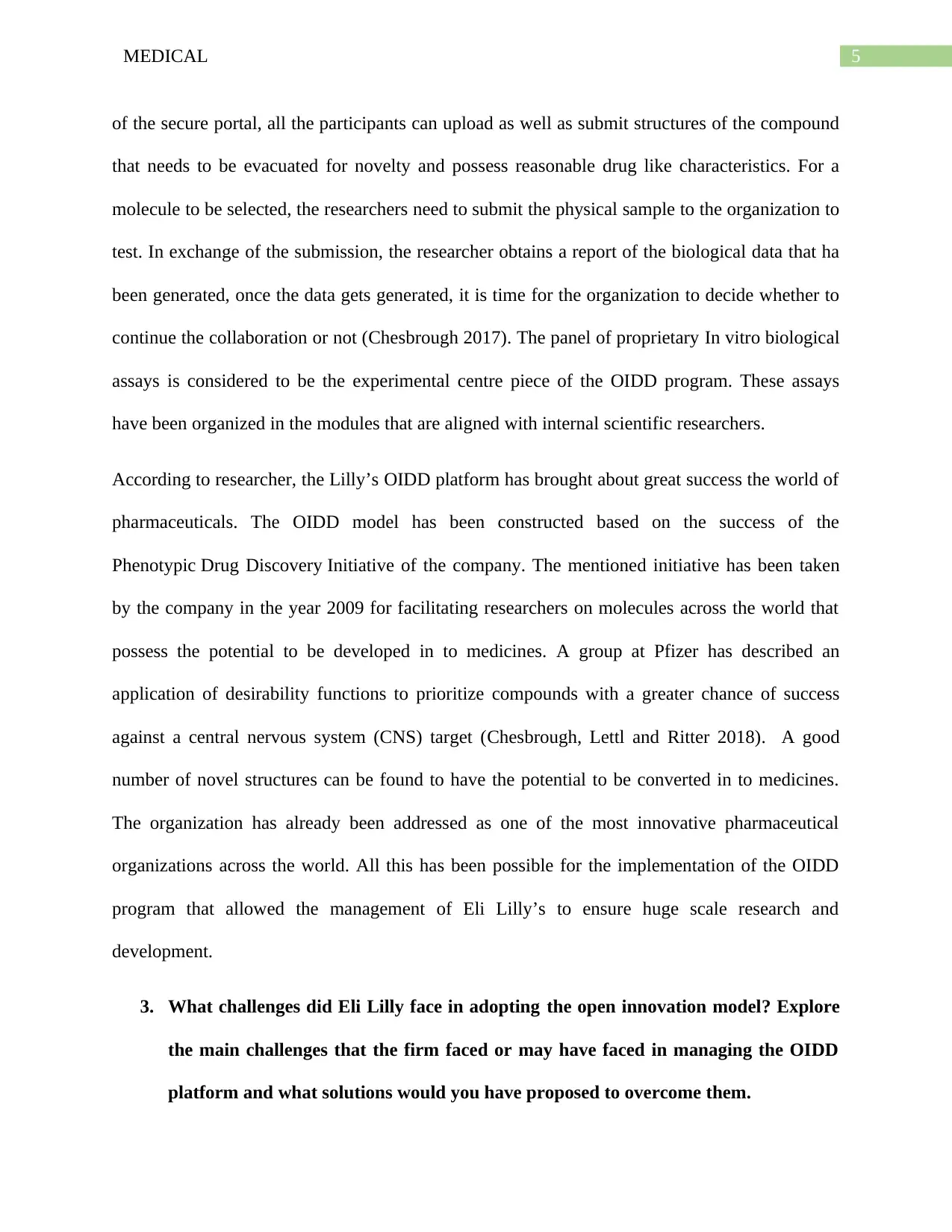
5MEDICAL
of the secure portal, all the participants can upload as well as submit structures of the compound
that needs to be evacuated for novelty and possess reasonable drug like characteristics. For a
molecule to be selected, the researchers need to submit the physical sample to the organization to
test. In exchange of the submission, the researcher obtains a report of the biological data that ha
been generated, once the data gets generated, it is time for the organization to decide whether to
continue the collaboration or not (Chesbrough 2017). The panel of proprietary In vitro biological
assays is considered to be the experimental centre piece of the OIDD program. These assays
have been organized in the modules that are aligned with internal scientific researchers.
According to researcher, the Lilly’s OIDD platform has brought about great success the world of
pharmaceuticals. The OIDD model has been constructed based on the success of the
Phenotypic Drug Discovery Initiative of the company. The mentioned initiative has been taken
by the company in the year 2009 for facilitating researchers on molecules across the world that
possess the potential to be developed in to medicines. A group at Pfizer has described an
application of desirability functions to prioritize compounds with a greater chance of success
against a central nervous system (CNS) target (Chesbrough, Lettl and Ritter 2018). A good
number of novel structures can be found to have the potential to be converted in to medicines.
The organization has already been addressed as one of the most innovative pharmaceutical
organizations across the world. All this has been possible for the implementation of the OIDD
program that allowed the management of Eli Lilly’s to ensure huge scale research and
development.
3. What challenges did Eli Lilly face in adopting the open innovation model? Explore
the main challenges that the firm faced or may have faced in managing the OIDD
platform and what solutions would you have proposed to overcome them.
of the secure portal, all the participants can upload as well as submit structures of the compound
that needs to be evacuated for novelty and possess reasonable drug like characteristics. For a
molecule to be selected, the researchers need to submit the physical sample to the organization to
test. In exchange of the submission, the researcher obtains a report of the biological data that ha
been generated, once the data gets generated, it is time for the organization to decide whether to
continue the collaboration or not (Chesbrough 2017). The panel of proprietary In vitro biological
assays is considered to be the experimental centre piece of the OIDD program. These assays
have been organized in the modules that are aligned with internal scientific researchers.
According to researcher, the Lilly’s OIDD platform has brought about great success the world of
pharmaceuticals. The OIDD model has been constructed based on the success of the
Phenotypic Drug Discovery Initiative of the company. The mentioned initiative has been taken
by the company in the year 2009 for facilitating researchers on molecules across the world that
possess the potential to be developed in to medicines. A group at Pfizer has described an
application of desirability functions to prioritize compounds with a greater chance of success
against a central nervous system (CNS) target (Chesbrough, Lettl and Ritter 2018). A good
number of novel structures can be found to have the potential to be converted in to medicines.
The organization has already been addressed as one of the most innovative pharmaceutical
organizations across the world. All this has been possible for the implementation of the OIDD
program that allowed the management of Eli Lilly’s to ensure huge scale research and
development.
3. What challenges did Eli Lilly face in adopting the open innovation model? Explore
the main challenges that the firm faced or may have faced in managing the OIDD
platform and what solutions would you have proposed to overcome them.
⊘ This is a preview!⊘
Do you want full access?
Subscribe today to unlock all pages.

Trusted by 1+ million students worldwide
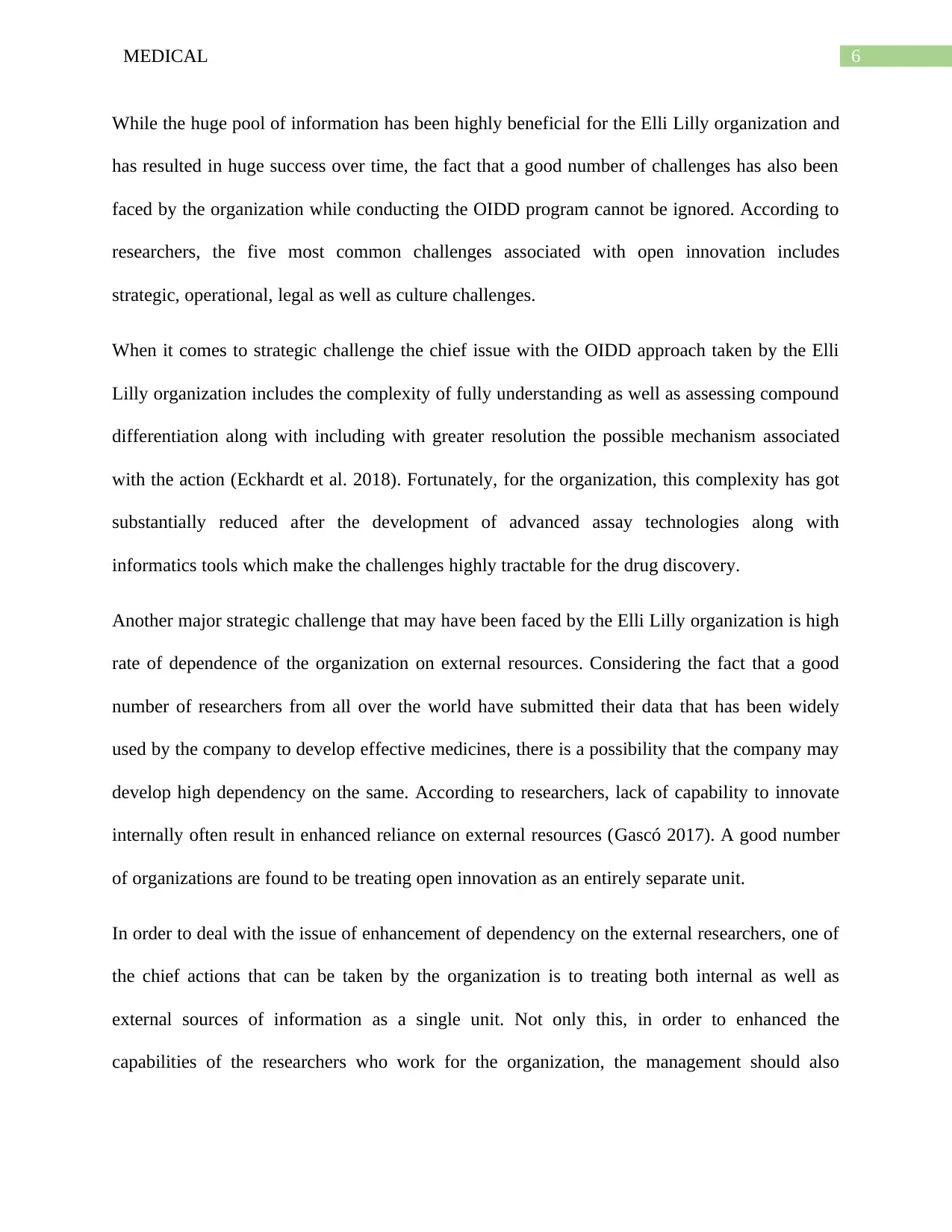
6MEDICAL
While the huge pool of information has been highly beneficial for the Elli Lilly organization and
has resulted in huge success over time, the fact that a good number of challenges has also been
faced by the organization while conducting the OIDD program cannot be ignored. According to
researchers, the five most common challenges associated with open innovation includes
strategic, operational, legal as well as culture challenges.
When it comes to strategic challenge the chief issue with the OIDD approach taken by the Elli
Lilly organization includes the complexity of fully understanding as well as assessing compound
differentiation along with including with greater resolution the possible mechanism associated
with the action (Eckhardt et al. 2018). Fortunately, for the organization, this complexity has got
substantially reduced after the development of advanced assay technologies along with
informatics tools which make the challenges highly tractable for the drug discovery.
Another major strategic challenge that may have been faced by the Elli Lilly organization is high
rate of dependence of the organization on external resources. Considering the fact that a good
number of researchers from all over the world have submitted their data that has been widely
used by the company to develop effective medicines, there is a possibility that the company may
develop high dependency on the same. According to researchers, lack of capability to innovate
internally often result in enhanced reliance on external resources (Gascó 2017). A good number
of organizations are found to be treating open innovation as an entirely separate unit.
In order to deal with the issue of enhancement of dependency on the external researchers, one of
the chief actions that can be taken by the organization is to treating both internal as well as
external sources of information as a single unit. Not only this, in order to enhanced the
capabilities of the researchers who work for the organization, the management should also
While the huge pool of information has been highly beneficial for the Elli Lilly organization and
has resulted in huge success over time, the fact that a good number of challenges has also been
faced by the organization while conducting the OIDD program cannot be ignored. According to
researchers, the five most common challenges associated with open innovation includes
strategic, operational, legal as well as culture challenges.
When it comes to strategic challenge the chief issue with the OIDD approach taken by the Elli
Lilly organization includes the complexity of fully understanding as well as assessing compound
differentiation along with including with greater resolution the possible mechanism associated
with the action (Eckhardt et al. 2018). Fortunately, for the organization, this complexity has got
substantially reduced after the development of advanced assay technologies along with
informatics tools which make the challenges highly tractable for the drug discovery.
Another major strategic challenge that may have been faced by the Elli Lilly organization is high
rate of dependence of the organization on external resources. Considering the fact that a good
number of researchers from all over the world have submitted their data that has been widely
used by the company to develop effective medicines, there is a possibility that the company may
develop high dependency on the same. According to researchers, lack of capability to innovate
internally often result in enhanced reliance on external resources (Gascó 2017). A good number
of organizations are found to be treating open innovation as an entirely separate unit.
In order to deal with the issue of enhancement of dependency on the external researchers, one of
the chief actions that can be taken by the organization is to treating both internal as well as
external sources of information as a single unit. Not only this, in order to enhanced the
capabilities of the researchers who work for the organization, the management should also
Paraphrase This Document
Need a fresh take? Get an instant paraphrase of this document with our AI Paraphraser
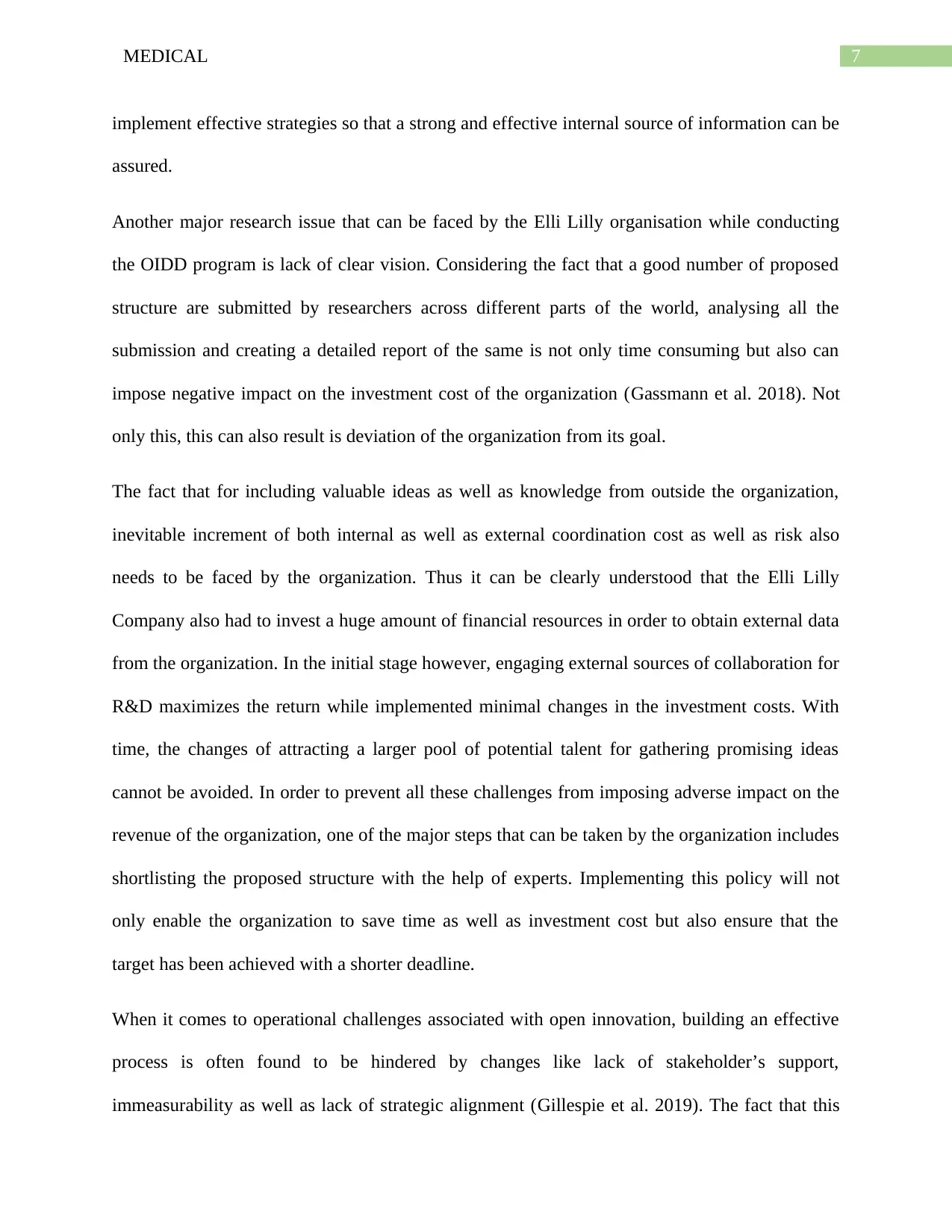
7MEDICAL
implement effective strategies so that a strong and effective internal source of information can be
assured.
Another major research issue that can be faced by the Elli Lilly organisation while conducting
the OIDD program is lack of clear vision. Considering the fact that a good number of proposed
structure are submitted by researchers across different parts of the world, analysing all the
submission and creating a detailed report of the same is not only time consuming but also can
impose negative impact on the investment cost of the organization (Gassmann et al. 2018). Not
only this, this can also result is deviation of the organization from its goal.
The fact that for including valuable ideas as well as knowledge from outside the organization,
inevitable increment of both internal as well as external coordination cost as well as risk also
needs to be faced by the organization. Thus it can be clearly understood that the Elli Lilly
Company also had to invest a huge amount of financial resources in order to obtain external data
from the organization. In the initial stage however, engaging external sources of collaboration for
R&D maximizes the return while implemented minimal changes in the investment costs. With
time, the changes of attracting a larger pool of potential talent for gathering promising ideas
cannot be avoided. In order to prevent all these challenges from imposing adverse impact on the
revenue of the organization, one of the major steps that can be taken by the organization includes
shortlisting the proposed structure with the help of experts. Implementing this policy will not
only enable the organization to save time as well as investment cost but also ensure that the
target has been achieved with a shorter deadline.
When it comes to operational challenges associated with open innovation, building an effective
process is often found to be hindered by changes like lack of stakeholder’s support,
immeasurability as well as lack of strategic alignment (Gillespie et al. 2019). The fact that this
implement effective strategies so that a strong and effective internal source of information can be
assured.
Another major research issue that can be faced by the Elli Lilly organisation while conducting
the OIDD program is lack of clear vision. Considering the fact that a good number of proposed
structure are submitted by researchers across different parts of the world, analysing all the
submission and creating a detailed report of the same is not only time consuming but also can
impose negative impact on the investment cost of the organization (Gassmann et al. 2018). Not
only this, this can also result is deviation of the organization from its goal.
The fact that for including valuable ideas as well as knowledge from outside the organization,
inevitable increment of both internal as well as external coordination cost as well as risk also
needs to be faced by the organization. Thus it can be clearly understood that the Elli Lilly
Company also had to invest a huge amount of financial resources in order to obtain external data
from the organization. In the initial stage however, engaging external sources of collaboration for
R&D maximizes the return while implemented minimal changes in the investment costs. With
time, the changes of attracting a larger pool of potential talent for gathering promising ideas
cannot be avoided. In order to prevent all these challenges from imposing adverse impact on the
revenue of the organization, one of the major steps that can be taken by the organization includes
shortlisting the proposed structure with the help of experts. Implementing this policy will not
only enable the organization to save time as well as investment cost but also ensure that the
target has been achieved with a shorter deadline.
When it comes to operational challenges associated with open innovation, building an effective
process is often found to be hindered by changes like lack of stakeholder’s support,
immeasurability as well as lack of strategic alignment (Gillespie et al. 2019). The fact that this
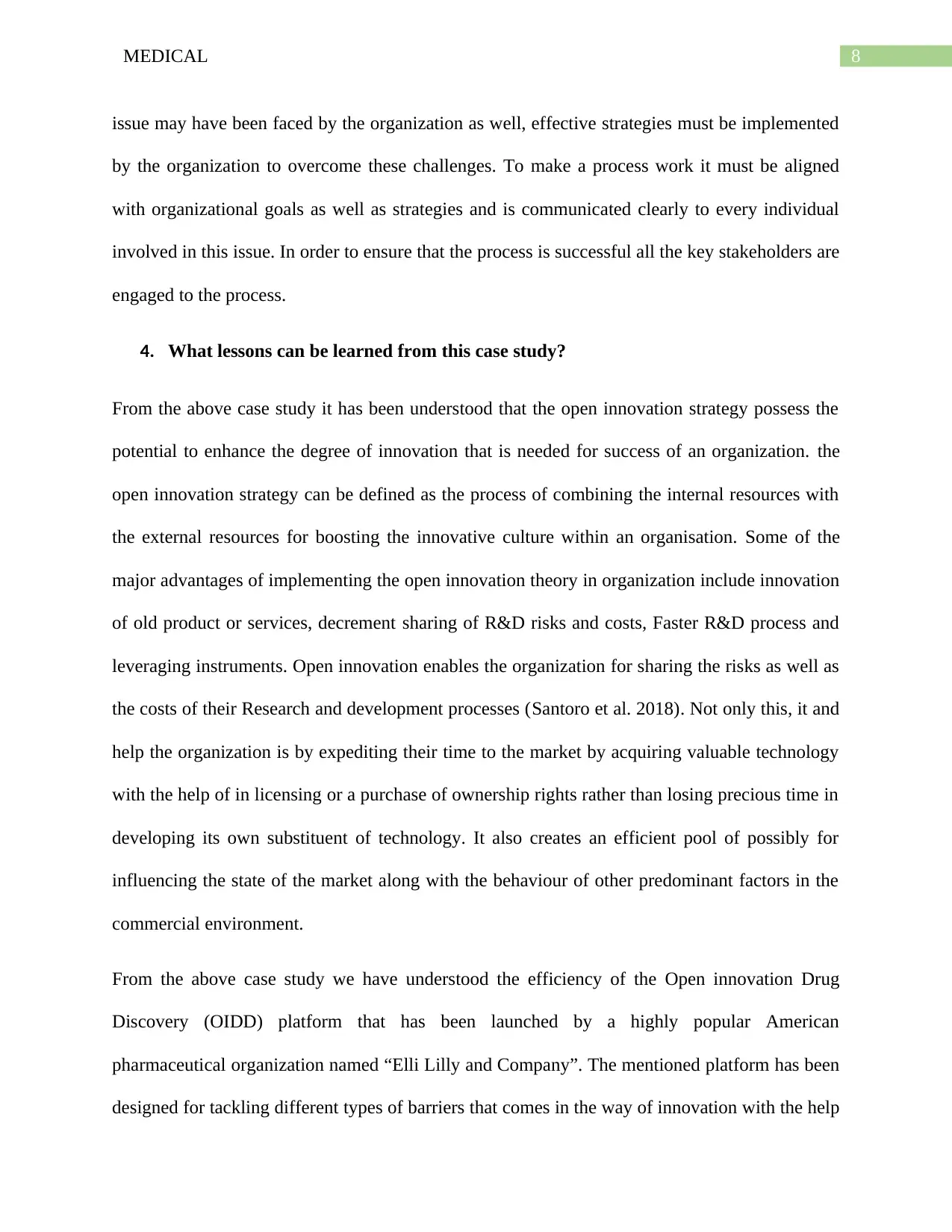
8MEDICAL
issue may have been faced by the organization as well, effective strategies must be implemented
by the organization to overcome these challenges. To make a process work it must be aligned
with organizational goals as well as strategies and is communicated clearly to every individual
involved in this issue. In order to ensure that the process is successful all the key stakeholders are
engaged to the process.
4. What lessons can be learned from this case study?
From the above case study it has been understood that the open innovation strategy possess the
potential to enhance the degree of innovation that is needed for success of an organization. the
open innovation strategy can be defined as the process of combining the internal resources with
the external resources for boosting the innovative culture within an organisation. Some of the
major advantages of implementing the open innovation theory in organization include innovation
of old product or services, decrement sharing of R&D risks and costs, Faster R&D process and
leveraging instruments. Open innovation enables the organization for sharing the risks as well as
the costs of their Research and development processes (Santoro et al. 2018). Not only this, it and
help the organization is by expediting their time to the market by acquiring valuable technology
with the help of in licensing or a purchase of ownership rights rather than losing precious time in
developing its own substituent of technology. It also creates an efficient pool of possibly for
influencing the state of the market along with the behaviour of other predominant factors in the
commercial environment.
From the above case study we have understood the efficiency of the Open innovation Drug
Discovery (OIDD) platform that has been launched by a highly popular American
pharmaceutical organization named “Elli Lilly and Company”. The mentioned platform has been
designed for tackling different types of barriers that comes in the way of innovation with the help
issue may have been faced by the organization as well, effective strategies must be implemented
by the organization to overcome these challenges. To make a process work it must be aligned
with organizational goals as well as strategies and is communicated clearly to every individual
involved in this issue. In order to ensure that the process is successful all the key stakeholders are
engaged to the process.
4. What lessons can be learned from this case study?
From the above case study it has been understood that the open innovation strategy possess the
potential to enhance the degree of innovation that is needed for success of an organization. the
open innovation strategy can be defined as the process of combining the internal resources with
the external resources for boosting the innovative culture within an organisation. Some of the
major advantages of implementing the open innovation theory in organization include innovation
of old product or services, decrement sharing of R&D risks and costs, Faster R&D process and
leveraging instruments. Open innovation enables the organization for sharing the risks as well as
the costs of their Research and development processes (Santoro et al. 2018). Not only this, it and
help the organization is by expediting their time to the market by acquiring valuable technology
with the help of in licensing or a purchase of ownership rights rather than losing precious time in
developing its own substituent of technology. It also creates an efficient pool of possibly for
influencing the state of the market along with the behaviour of other predominant factors in the
commercial environment.
From the above case study we have understood the efficiency of the Open innovation Drug
Discovery (OIDD) platform that has been launched by a highly popular American
pharmaceutical organization named “Elli Lilly and Company”. The mentioned platform has been
designed for tackling different types of barriers that comes in the way of innovation with the help
⊘ This is a preview!⊘
Do you want full access?
Subscribe today to unlock all pages.

Trusted by 1+ million students worldwide
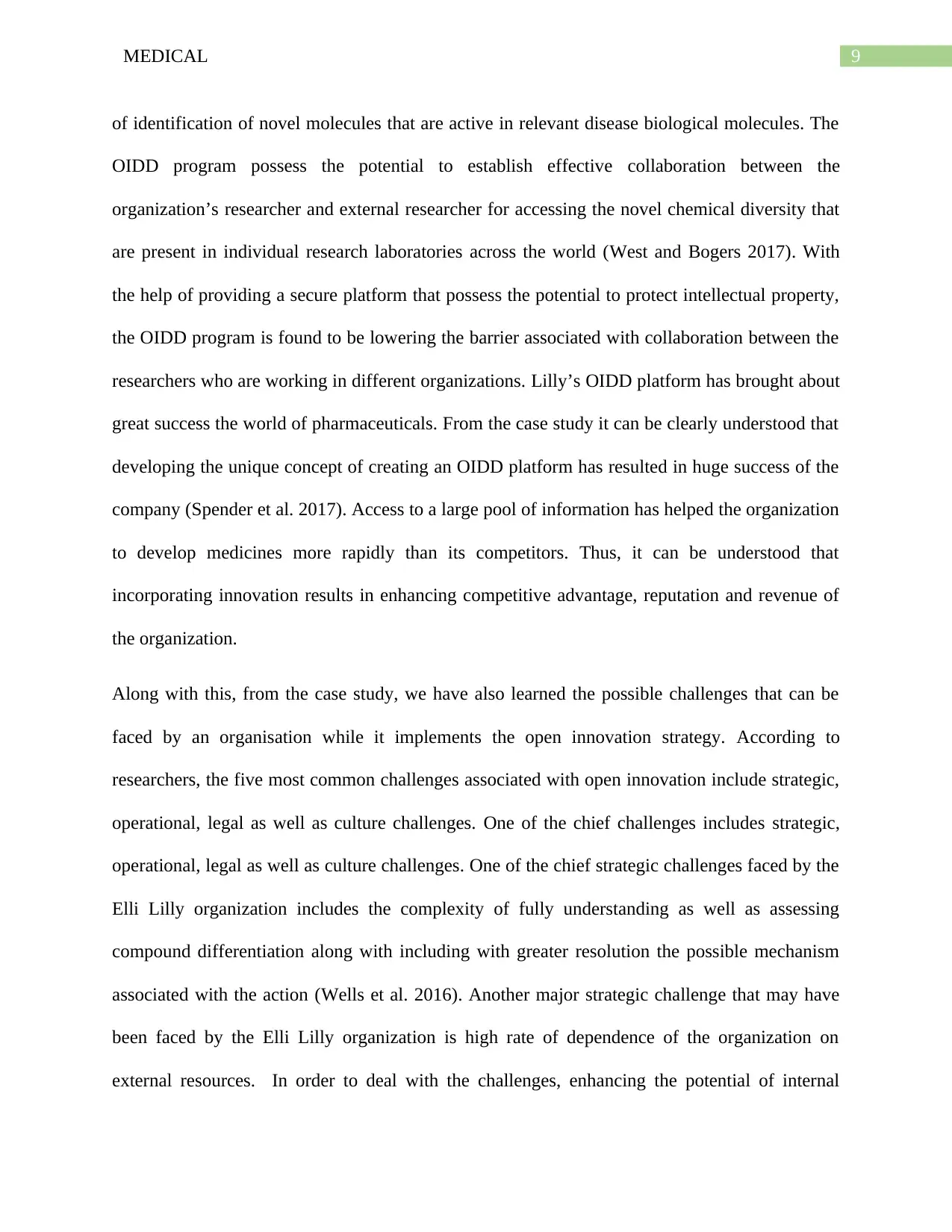
9MEDICAL
of identification of novel molecules that are active in relevant disease biological molecules. The
OIDD program possess the potential to establish effective collaboration between the
organization’s researcher and external researcher for accessing the novel chemical diversity that
are present in individual research laboratories across the world (West and Bogers 2017). With
the help of providing a secure platform that possess the potential to protect intellectual property,
the OIDD program is found to be lowering the barrier associated with collaboration between the
researchers who are working in different organizations. Lilly’s OIDD platform has brought about
great success the world of pharmaceuticals. From the case study it can be clearly understood that
developing the unique concept of creating an OIDD platform has resulted in huge success of the
company (Spender et al. 2017). Access to a large pool of information has helped the organization
to develop medicines more rapidly than its competitors. Thus, it can be understood that
incorporating innovation results in enhancing competitive advantage, reputation and revenue of
the organization.
Along with this, from the case study, we have also learned the possible challenges that can be
faced by an organisation while it implements the open innovation strategy. According to
researchers, the five most common challenges associated with open innovation include strategic,
operational, legal as well as culture challenges. One of the chief challenges includes strategic,
operational, legal as well as culture challenges. One of the chief strategic challenges faced by the
Elli Lilly organization includes the complexity of fully understanding as well as assessing
compound differentiation along with including with greater resolution the possible mechanism
associated with the action (Wells et al. 2016). Another major strategic challenge that may have
been faced by the Elli Lilly organization is high rate of dependence of the organization on
external resources. In order to deal with the challenges, enhancing the potential of internal
of identification of novel molecules that are active in relevant disease biological molecules. The
OIDD program possess the potential to establish effective collaboration between the
organization’s researcher and external researcher for accessing the novel chemical diversity that
are present in individual research laboratories across the world (West and Bogers 2017). With
the help of providing a secure platform that possess the potential to protect intellectual property,
the OIDD program is found to be lowering the barrier associated with collaboration between the
researchers who are working in different organizations. Lilly’s OIDD platform has brought about
great success the world of pharmaceuticals. From the case study it can be clearly understood that
developing the unique concept of creating an OIDD platform has resulted in huge success of the
company (Spender et al. 2017). Access to a large pool of information has helped the organization
to develop medicines more rapidly than its competitors. Thus, it can be understood that
incorporating innovation results in enhancing competitive advantage, reputation and revenue of
the organization.
Along with this, from the case study, we have also learned the possible challenges that can be
faced by an organisation while it implements the open innovation strategy. According to
researchers, the five most common challenges associated with open innovation include strategic,
operational, legal as well as culture challenges. One of the chief challenges includes strategic,
operational, legal as well as culture challenges. One of the chief strategic challenges faced by the
Elli Lilly organization includes the complexity of fully understanding as well as assessing
compound differentiation along with including with greater resolution the possible mechanism
associated with the action (Wells et al. 2016). Another major strategic challenge that may have
been faced by the Elli Lilly organization is high rate of dependence of the organization on
external resources. In order to deal with the challenges, enhancing the potential of internal
Paraphrase This Document
Need a fresh take? Get an instant paraphrase of this document with our AI Paraphraser
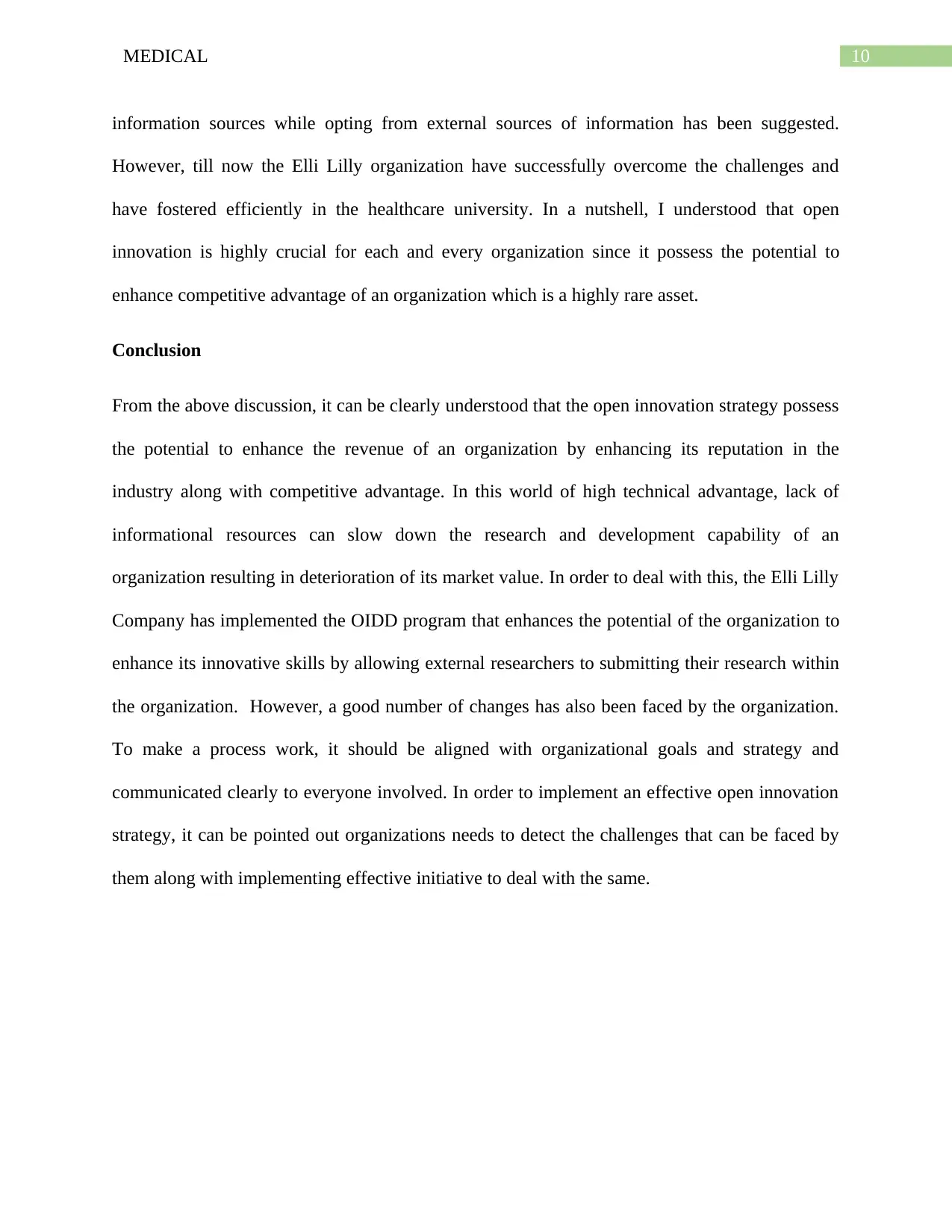
10MEDICAL
information sources while opting from external sources of information has been suggested.
However, till now the Elli Lilly organization have successfully overcome the challenges and
have fostered efficiently in the healthcare university. In a nutshell, I understood that open
innovation is highly crucial for each and every organization since it possess the potential to
enhance competitive advantage of an organization which is a highly rare asset.
Conclusion
From the above discussion, it can be clearly understood that the open innovation strategy possess
the potential to enhance the revenue of an organization by enhancing its reputation in the
industry along with competitive advantage. In this world of high technical advantage, lack of
informational resources can slow down the research and development capability of an
organization resulting in deterioration of its market value. In order to deal with this, the Elli Lilly
Company has implemented the OIDD program that enhances the potential of the organization to
enhance its innovative skills by allowing external researchers to submitting their research within
the organization. However, a good number of changes has also been faced by the organization.
To make a process work, it should be aligned with organizational goals and strategy and
communicated clearly to everyone involved. In order to implement an effective open innovation
strategy, it can be pointed out organizations needs to detect the challenges that can be faced by
them along with implementing effective initiative to deal with the same.
information sources while opting from external sources of information has been suggested.
However, till now the Elli Lilly organization have successfully overcome the challenges and
have fostered efficiently in the healthcare university. In a nutshell, I understood that open
innovation is highly crucial for each and every organization since it possess the potential to
enhance competitive advantage of an organization which is a highly rare asset.
Conclusion
From the above discussion, it can be clearly understood that the open innovation strategy possess
the potential to enhance the revenue of an organization by enhancing its reputation in the
industry along with competitive advantage. In this world of high technical advantage, lack of
informational resources can slow down the research and development capability of an
organization resulting in deterioration of its market value. In order to deal with this, the Elli Lilly
Company has implemented the OIDD program that enhances the potential of the organization to
enhance its innovative skills by allowing external researchers to submitting their research within
the organization. However, a good number of changes has also been faced by the organization.
To make a process work, it should be aligned with organizational goals and strategy and
communicated clearly to everyone involved. In order to implement an effective open innovation
strategy, it can be pointed out organizations needs to detect the challenges that can be faced by
them along with implementing effective initiative to deal with the same.
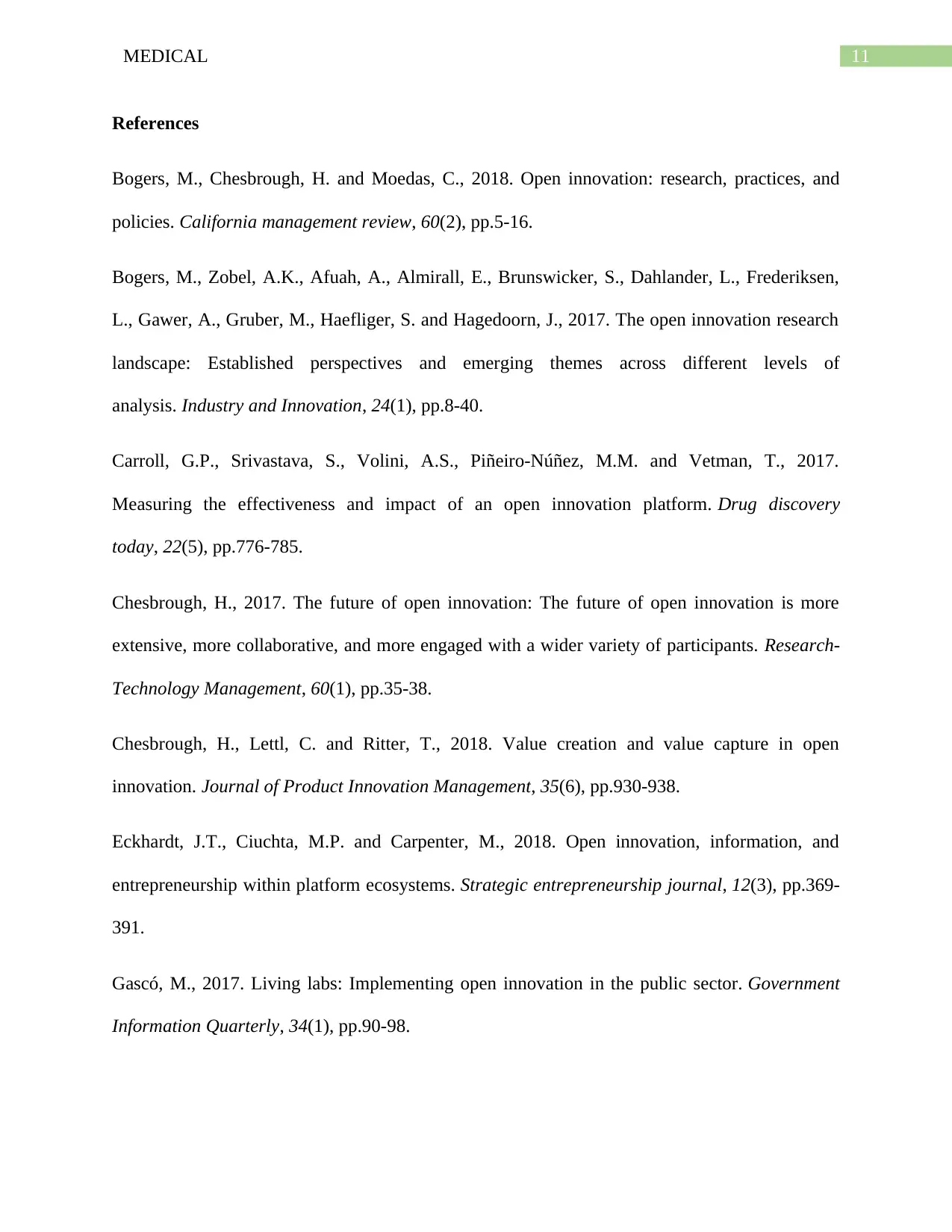
11MEDICAL
References
Bogers, M., Chesbrough, H. and Moedas, C., 2018. Open innovation: research, practices, and
policies. California management review, 60(2), pp.5-16.
Bogers, M., Zobel, A.K., Afuah, A., Almirall, E., Brunswicker, S., Dahlander, L., Frederiksen,
L., Gawer, A., Gruber, M., Haefliger, S. and Hagedoorn, J., 2017. The open innovation research
landscape: Established perspectives and emerging themes across different levels of
analysis. Industry and Innovation, 24(1), pp.8-40.
Carroll, G.P., Srivastava, S., Volini, A.S., Piñeiro-Núñez, M.M. and Vetman, T., 2017.
Measuring the effectiveness and impact of an open innovation platform. Drug discovery
today, 22(5), pp.776-785.
Chesbrough, H., 2017. The future of open innovation: The future of open innovation is more
extensive, more collaborative, and more engaged with a wider variety of participants. Research-
Technology Management, 60(1), pp.35-38.
Chesbrough, H., Lettl, C. and Ritter, T., 2018. Value creation and value capture in open
innovation. Journal of Product Innovation Management, 35(6), pp.930-938.
Eckhardt, J.T., Ciuchta, M.P. and Carpenter, M., 2018. Open innovation, information, and
entrepreneurship within platform ecosystems. Strategic entrepreneurship journal, 12(3), pp.369-
391.
Gascó, M., 2017. Living labs: Implementing open innovation in the public sector. Government
Information Quarterly, 34(1), pp.90-98.
References
Bogers, M., Chesbrough, H. and Moedas, C., 2018. Open innovation: research, practices, and
policies. California management review, 60(2), pp.5-16.
Bogers, M., Zobel, A.K., Afuah, A., Almirall, E., Brunswicker, S., Dahlander, L., Frederiksen,
L., Gawer, A., Gruber, M., Haefliger, S. and Hagedoorn, J., 2017. The open innovation research
landscape: Established perspectives and emerging themes across different levels of
analysis. Industry and Innovation, 24(1), pp.8-40.
Carroll, G.P., Srivastava, S., Volini, A.S., Piñeiro-Núñez, M.M. and Vetman, T., 2017.
Measuring the effectiveness and impact of an open innovation platform. Drug discovery
today, 22(5), pp.776-785.
Chesbrough, H., 2017. The future of open innovation: The future of open innovation is more
extensive, more collaborative, and more engaged with a wider variety of participants. Research-
Technology Management, 60(1), pp.35-38.
Chesbrough, H., Lettl, C. and Ritter, T., 2018. Value creation and value capture in open
innovation. Journal of Product Innovation Management, 35(6), pp.930-938.
Eckhardt, J.T., Ciuchta, M.P. and Carpenter, M., 2018. Open innovation, information, and
entrepreneurship within platform ecosystems. Strategic entrepreneurship journal, 12(3), pp.369-
391.
Gascó, M., 2017. Living labs: Implementing open innovation in the public sector. Government
Information Quarterly, 34(1), pp.90-98.
⊘ This is a preview!⊘
Do you want full access?
Subscribe today to unlock all pages.

Trusted by 1+ million students worldwide
1 out of 13
Related Documents
Your All-in-One AI-Powered Toolkit for Academic Success.
+13062052269
info@desklib.com
Available 24*7 on WhatsApp / Email
![[object Object]](/_next/static/media/star-bottom.7253800d.svg)
Unlock your academic potential
Copyright © 2020–2025 A2Z Services. All Rights Reserved. Developed and managed by ZUCOL.





